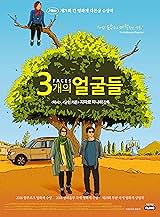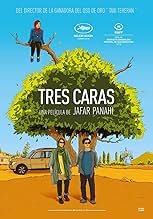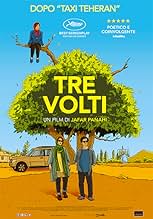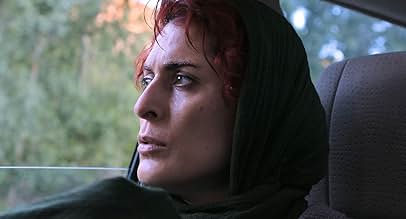Se rokh
- 2018
- 1 घं 40 मि
अपनी भाषा में प्लॉट जोड़ेंThree actresses at different stages of their career. One from before the 1979 Islamic Revolution, one popular star of today known throughout the country, and a young girl longing to attend a... सभी पढ़ेंThree actresses at different stages of their career. One from before the 1979 Islamic Revolution, one popular star of today known throughout the country, and a young girl longing to attend a drama conservatory.Three actresses at different stages of their career. One from before the 1979 Islamic Revolution, one popular star of today known throughout the country, and a young girl longing to attend a drama conservatory.
- पुरस्कार
- 5 जीत और कुल 9 नामांकन
- Marziyeh's mother
- (as Narges Del Aram)
- Karbalaei
- (as Ahmad Naderi Mehr)
- Sorkhpost
- (बिना क्रेडिट के)
फ़ीचर्ड समीक्षाएं
Watching this movie, I got the feeling that life in Iran's hinterlands must be a miserable existence. It's not a great movie, but worth seeing as a look at people whom we don't often see.
Let's all hope for a day of no limitations and closed borders.
Metafiction, docufiction and everything in between. Of course, it's Jafar Panahi, it's expected to find plenty of discourse about movie-making and its difficulties. At one point, the actress is trying to explain to an old villager that the actor he admires cannot come back to Iran anymore and Panahi cannot leave Iran. It's a short line, we get it. The man doesn't, of course, but it wasn't really for him. There's also a healthy dose of criticism against the patriarchy by merely observing these people and letting it all play out. There is no discourse served to the audience, no loud, rousing statements. Some of these men would kill to avenge their skewed idea of honour.
Although I appreciated most of the scenes, it did feel a little too long, although it's really not, and maybe Panahi's metafiction is beginning to wear me out. But I guess he did get a chance to make the movie he was referring to in "This Is Not a Film". At least the core idea from there is the same, even if the story goes to a different place. Girl from a conservative family wants to study, but her family forbids it. She contemplates suicide.
Prior to the Iranian Revolution of 1980, cinema in Iran was very popular. The country had a mature film-making industry that churned out products ranging from adventure films with virile male characters to important art films from internationally-recognized directors such as Abbas Kiarostami.
After the Ayatollah took over the country, these films were banned. Some artists managed to flee the country while others stayed and became outcasts like the old actress in this movie. Panahi intentionally never shows us her face, a reminder that Iranians are not permitted to view the films that comprise Iranian cinematic heritage. The old actress lives in a very humble house in a remote part of a very remote village, in the same way that Iranian film history exists, but has been tucked away from view by the mullahs, and stuck into a place unfitting its true stature. There is a very interesting scene in which, from a distance, Panahi sees all three actresses dancing and partying in the house. It is as if he is saying he knows there is a lot of great substance in the historic Iranian films, but he himself cannot enjoy it, given his own present circumstance as an Iranian filmmaker whose films are banned in his own country.
The middle-aged actress (played brilliantly by Behnaz Jafari) represents the current state of Iranian cinema, which is to say it is practically nonexistent. In this movie she is a TV actress who stars in cheap soap operas. Early in the film, Panahi describes her as follows: "in her current state she's not much use to anyone, anyway." Ouch.
Perhaps the most interesting of the three faces is that of the young actress, who represents Panahi's assessment of the future of Iranian cinema, which turns out not to be traditional cinema at all. This actress stars in a smart phone-produced video that might or might not be staged. The filmmakers of the future, he seems to be saying, will be unconstrained by whether a work might be categorized as fiction or non-fiction, but instead focused on important sociological themes that move people to act. Indeed, a look at present day Iranian Youtube videos reveals works that deal with social upheaval. One example: a woman wears her hijab too low on the bus and films away as a religious zealot spits in her face. These are the most important films coming out of Iran today.
Beyond its subtext, this film is very rich in terms of presenting for western viewers a look at a part of the world we rarely get to see. Panahi's portrayal of the people of rural Iran along the Turkish border seems very genuine. He presents them as multifaceted and interesting; we get a good dose of the good, the bad and the ugly in these people. The film is worth seeing for that alone.
क्या आपको पता है
- ट्रिवियाIt is filmed in a remote Turkish-Azeri-speaking part of Iran where Panahi's parents hail from.
- भाव
Jafar Panahi: Listen, it's you who see,but I think you were very hard with her. People here are not used to that.They get upset quickly and forget even faster. Since we're going back there, try to make amends. But it's up to you.
टॉप पसंद
- How long is 3 Faces?Alexa द्वारा संचालित
विवरण
- रिलीज़ की तारीख़
- कंट्री ऑफ़ ओरिजिन
- आधिकारिक साइटें
- भाषाएं
- इस रूप में भी जाना जाता है
- Tres rostros
- फ़िल्माने की जगहें
- Miyaneh County, East Azerbaijan Province, ईरान(Rural Areas)
- उत्पादन कंपनियां
- IMDbPro पर और कंपनी क्रेडिट देखें
बॉक्स ऑफ़िस
- US और कनाडा में सकल
- $72,324
- US और कनाडा में पहले सप्ताह में कुल कमाई
- $7,065
- 10 मार्च 2019
- दुनिया भर में सकल
- $21,91,516
- चलने की अवधि1 घंटा 40 मिनट
- रंग
- ध्वनि मिश्रण
- पक्ष अनुपात
- 1.85 : 1
इस पेज में योगदान दें

























